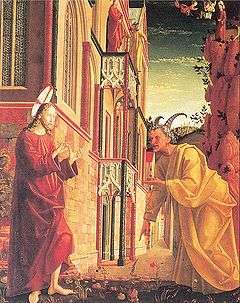Matthew 4:5
Matthew 4:5 is the fifth verse of the fourth chapter of the Gospel of Matthew in the New Testament. Jesus has just rebuffed Satan's first temptation in this verse the devil transports him to the site of the second temptation.
| Matthew 4:5 | |
|---|---|
← 4:4 4:6 → | |
 Temptation of Christ by Michael Pacher (1435-1598) | |
| Book | Gospel of Matthew |
| Christian Bible part | New Testament |
Content
In the King James Version of the Bible the text reads:
- Then the devil taketh him up
- into the holy city, and setteth
- him on a pinnacle of the temple,
The World English Bible translates the passage as:
- Then the devil took him into
- the holy city. He set him on
- the pinnacle of the temple,
For a collection of other versions see BibleHub Matthew 4:5
Analysis
The "holy city" is unquestionably a reference to Jerusalem, as the mention of The Temple makes clear. In Luke's version of this scene at Luke 4:9 the city is named as such. Both names are used in the retelling of this event in Revelation 21:10.
Nolland notes that the word translated as taketh/took here and in Matthew 4:8 is the same verb as was used to refer to Joseph taking Jesus to Egypt and back in Matthew 2:14 and Matthew 2:21. Nolland feels that this establishes a subtle contrast between Joseph's righteous transportation of Jesus and Satan's evil designs.[1]
What is meant by the word traditionally translated as "pinnacle" is not entirely clear. Schweizer notes that in Greek the term is very similar to "little wings" he feels that "little tower" or "parapet" would be a more accurate translation.[2] France notes that the word occurs nowhere in classical literature to refer to an architectural feature, though it is used in reference to a projection from a piece of armour or machinery.[3] Harrington believes that the verse may be linked to the reference to protecting wings in Psalm 91:4.[4] Gundry lists three sites on the temple that have been considered for the setting of this scene. Artists and others using the traditional translation "pinnacle" generally set the event on the top of the temple's main tower above the sanctuary proper, some 180 feet above ground. Another view is that it was set atop the lintel of the main gateway into the temple, the most prominent position where the pair could easily have been seen. The third site, and that adopted by tradition, is that it was at a tower the southeast corner of the outer wall that looks down into the Kidron Valley. In a related tradition James the Just was said to have been executed by being thrown from this same tower.[5]
References
- Nolland, John. The Gospel of Matthew: a commentary on the Greek text. Wm. B. Eerdmans Publishing, 2005 pg. 165
- Schweizer, Eduard. The Good News According to Matthew. Atlanta: John Knox Press, 1975
- France, R.T.. The Gospel of Matthew. Wm. B. Eerdmans Publishing, 2007 pg. 132
- Harrington, Daniel J. The Gospel of Matthew. Liturgical Press, 1991 pg. 66
- Gundry, Robert H. Matthew a Commentary on his Literary and Theological Art. Grand Rapids: William B. Eerdmans Publishing Company, 1982.
| Preceded by Matthew 4:4 |
Gospel of Matthew Chapter 4 |
Succeeded by Matthew 4:6 |